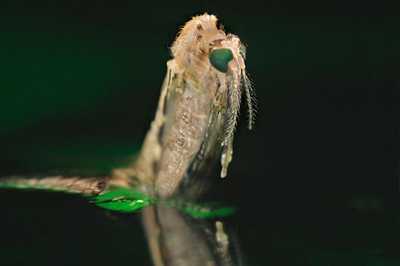AMD Project: Battling Insecticide-resistance in Malaria Vectors
Using AMD methods to develop tools for the detection and management of insecticide resistance in mosquitoes that transmit malaria

Malaria is a serious and sometimes fatal disease caused by a parasite that commonly infects mosquitoes. Control of mosquitoes, such as this emerging Anopheles mosquito, is critical to controlling and preventing malaria.
Did you know CDC grew out of the World War II-era initiative called Malaria Control in War Areas (MCWA)? This early effort to fight malaria focused on killing mosquitoes in the Southern United States and entomologists and engineers were on the front lines of the battle. In fact, CDC had only seven medical officers on staff in 1946; over half of the personnel had a singular mission – kill mosquitoes.
In order to accomplish this mission, chemical pesticide became the primary weapon. Among the biggest challenges in the fight was obtaining enough trucks and sprayers to wage the war on mosquitoes. This intense mosquito control initiative successfully eradicated malaria from the United States in the early 1950s.
But malaria is still a global threat. The World Health Organization estimates that there were 198 million cases of malaria worldwide in 2013 and malaria caused 584,000 deaths that year. About 3.3 billion people—nearly half the world’s population—currently live in areas where they are at risk of malaria. And the United States is not immune, each year about 1,500 travelers returning to the U.S. bring back “imported malaria.”
Malaria is a serious and sometimes fatal disease caused by a parasite that commonly infects mosquitoes. When the mosquitoes feed on humans, they transmit the parasite to their human hosts. People with malaria typically have high fevers, shaking chills, and flu-like illness. Although malaria can be deadly, illness and death from malaria can usually be prevented.
While effective, current methods for fighting malaria—including improved diagnostic tests, drugs, insecticides, and insecticide-treated bed nets—have not fully succeeded in eliminating the disease. Control of mosquitoes is therefore critical to malaria prevention and control. But one of the biggest threats to malaria control is the development of insecticide resistance in the mosquitoes that transmit malaria parasites. Decades of unmanaged insecticide use and routine exposure to chemicals have left many populations of mosquitoes resistant to multiple insecticides, including pyrethroids, which are the most cost-effective public health insecticides currently available.
In order to combat insecticide resistance, we urgently need diagnostic tools to better understand how insecticide resistance is affecting malaria control interventions. Through this project, CDC will use AMD methods to identify the ways pyrethroid resistance occurs in one of the most important malaria vectors in the Americas, the Anopheles albimanus mosquito, by identifying molecular markers of resistance. The application of these tools in the field will inform the appropriate selection of insecticides for malaria vector control, helping ensure maximum mosquito control efficacy and effective implementation of insecticide resistance management strategies.
2017 Project Update
In its first year, project investigators detected several genetic markers in the Anopheles albimanus mosquito that appear to be specific to pyrethroid resistance. Researchers have seen some of these markers in other mosquito species. Armed with this information, CDC and Liverpool School of Tropical Medicine researchers will collaborate in the coming year to develop a new genomics-based tool to detect pyrethroid resistance in Western Hemisphere mosquitoes. The outcome of this work will maintain the efficacy of pesticides available to control mosquitoes as we continue to strive to achieve malaria elimination. This work will be especially critical to maintaining the success of malaria control in the Americas.
- Page last reviewed: March 27, 2017
- Page last updated: March 27, 2017
- Content source:


 ShareCompartir
ShareCompartir